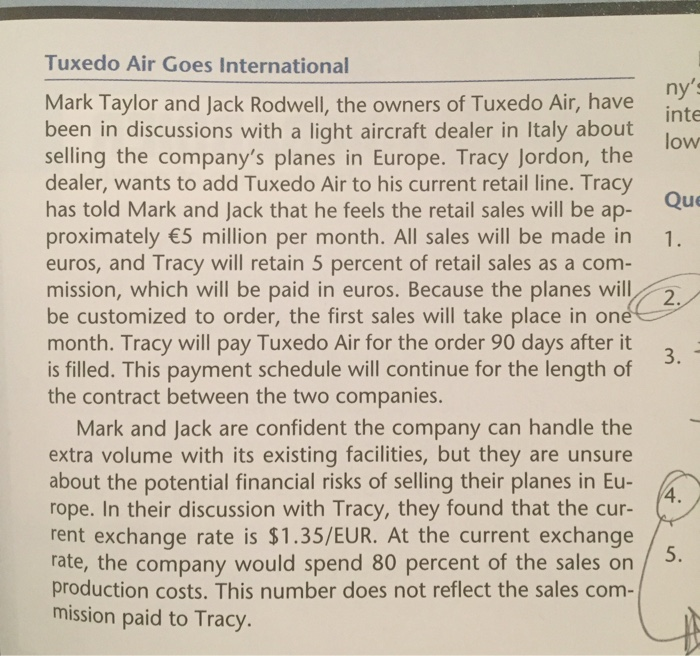can someone please assist with 2b and 2c and 2d you need 2b to do the rest.

ny's do Air, have inte low Que 1. Tuxedo Air Goes International Mark Taylor and Jack Rodwell, the owners of Tuxedo Air, have been in discussions with a light aircraft dealer in Italy about selling the company's planes in Europe. Tracy Jordon, the dealer, wants to add Tuxedo Air to his current retail line. Tracy has told Mark and Jack that he feels the retail sales will be ap- proximately 5 million per month. All sales will be made in euros, and Tracy will retain 5 percent of retail sales as a com- mission, which will be paid in euros. Because the planes will be customized to order, the first sales will take place in one month. Tracy will pay Tuxedo Air for the order 90 days after it is filled. This payment schedule will continue for the length of the contract between the two companies. Mark and Jack are confident the company can handle the extra volume with its existing facilities, but they are unsure about the potential financial risks of selling their planes in Eu- rope. In their discussion with Tracy, they found that the cur- rent exchange rate is $1.35/EUR. At the current exchange rate, the company would spend 80 percent of the sales on production costs. This number does not reflect the sales com- mission paid to Tracy. 3. Question #2: International Corporate Finance (Chapter 21) This is a modified version of Chapter 21 Mini Case, in the Ross book (9* CAN edition). Note: The setting is exactly the same as presented in Chapter 21 Mini Case, on page 846 in the Ross book. However, you should answer the questions raised below which are slightly different from the questions used in the textbook. IQuestion 2.a) What happens to Tuxedo Air's profits if the dollar strengthens against Euro? What if the dollar weakens? Question 2.b) Ignoring taxes, calculate Tuxedo Air's projected gains or losses from this proposed arrangement at the current exchange rate of $1.35/EUR. IQuestion 2.c) What happens to the company's profits if the exchange rate changes to $1. 12/EUR, assuming that operating costs are fixed regardless of the FX rate movements? Question 2.d) How would the company hedge its exchange rate risk using a forward contract with a forward rate of $1.25/EUR? What are the implications for this approach









